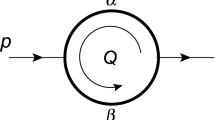Abstract
We study a problem in associative rings of left and right factorization of a polynomial differential operator regarded as an evolution operator. In a direct sum of rings, the polynomial arising in the problem of dividing an operator by an operator for two commuting operators leads to a time-dependent left/right Darboux transformation based on an intertwining relation and either Miura maps or generalized Burgers equations. The intertwining relations lead to a differential equation including differentiations in a weak sense. In view of applications to operator problems in quantum and classical mechanics, we derive the direct quasideterminant or dressing chain formulas. We consider the transformation of creation and annihilation operators for specified matrix rings and study an example of the Dicke model.
Similar content being viewed by others
References
V. B. Matveev, “Darboux transformations in associative rings and functional-difference equations,” in: The Bispectral Problem (CRM Proc. Lect. Notes, Vol. 14, J. Harnad and A. Kasman, eds.), Amer. Math. Soc., Providence, R. I. (1998), pp. 211–226.
E. V. Doktorov and S. B. Leble, A Dressing Method in Mathematical Physics (Math. Phys. Stud., Vol. 28), Springer, Dordrecht (2007).
N. N. Bogolubov and N. N. Bogolubov Jr., Introduction to Quantum Statistical Mechanics [in Russian], Nauka, Moscow (1984); English transl. prev. ed., World Scientific, Singapore (1982).
S. B. Leble, “Response of a classical many-particle system to a two-pulse excitation [in Russian],” in: Coherent Excitation of Condensed Matter (U. Kh. Kopvillem, ed.), Far East Science Center, Acad. Sci., USSR, Vladivostok (1979), pp. 51–74
B. Leble and A. I. Ivanov, Method of Second Quantization [in Russian], Kaliningrad State Univ., Kaliningrad (1981).
S. B. Leble, “Dressing method in matter+radiation quantum models,” Theor. Math. Phys., 152, 977–990 (2007).
L. I. Men’shikov, “Superradiance and related phenomena,” Phys. Usp., 42, 107–147 (1999).
N. M. Bogoliubov and P. P. Kulish, “Exactly solvable models of quantum nonlinear optics,” J. Math. Sci. (N. Y.), 192, 14–30 (2013).
V. B. Matveev, “Darboux transformation and explicit solutions of the Kadomtcev–Petviaschvily equation, depending on functional parameters,” Lett. Math. Phys., 3, 213–216 (1979).
S. Leble and A. Zaitsev, “Division of differential operators, intertwine relations, and Darboux transformations,” Rep. Math. Phys., 46, 165–174 (2000).
P. Dubard and V. B. Matveev, “Multi-rogue waves solutions: From the NLS to the KP-I equation,” Nonlinearity, 26, R93–R125 (2013).
Author information
Authors and Affiliations
Corresponding author
Additional information
Prepared from an English manuscript submitted by the author; for the Russian version, see Teoreticheskaya i Matematicheskaya Fizika, Vol. 197, No. 1, pp. 108–123, October, 2018.
Rights and permissions
About this article
Cite this article
Leble, S.B. Integrable Potentials by Darboux Transformations in Rings and Quantum and Classical Problems. Theor Math Phys 197, 1487–1500 (2018). https://doi.org/10.1134/S0040577918100069
Published:
Issue Date:
DOI: https://doi.org/10.1134/S0040577918100069



